Understanding the Intersection of PTSD and Autism Spectrum Disorder
As scientific interest grows in the realm of mental health, particular attention has been given to the overlap and distinctions between Post-Traumatic Stress Disorder (PTSD) and Autism Spectrum Disorder (ASD). Both conditions involve significant challenges in emotional processing, social interaction, and behavior, but stem from fundamentally different origins and require distinct approaches to diagnosis and treatment. This exploration seeks to demystify the nuances of PTSD and autism — particularly focusing on how trauma impacts individuals with autism, how symptoms can intersect, and how interventions such as Applied Behavior Analysis (ABA) therapy support this population.
Prevalence of Trauma and PTSD in Individuals with Autism Spectrum Disorder

Increased Vulnerability to Trauma in ASD
Individuals with Autism Spectrum Disorder (ASD) face a heightened risk of experiencing traumatic events. Core features of ASD such as social naiveté, difficulties in communication, and impairments in social cognition increase vulnerability to maltreatment, abuse, and social manipulation. These challenges raise the likelihood of encountering potentially traumatic situations more often than their neurotypical peers.
Higher Rates of PTSD Among Autistic Individuals
Research consistently shows that autistic individuals have higher rates of Post-Traumatic Stress Disorder (PTSD) when compared to the general population. The compounded effect of emotional regulation deficits, hypersensitivity to stress, and reactive nervous system functioning may predispose them to developing PTSD symptoms, including intrusive memories, nightmares, and emotional numbness.
Statistical Trends and Research Interest
In recent years, scientific interest in trauma experiences within the ASD population has surged. Numerous studies have highlighted increased vulnerability and prevalence rates, pointing towards the need for focused assessment and tailored interventions. Though precise prevalence rates vary, many individuals with autism report experiencing PTSD during their lifetime, underscoring the importance of recognizing trauma's impact in this group.
Core Characteristics of Autism Spectrum Disorder and Their Role in Trauma Susceptibility
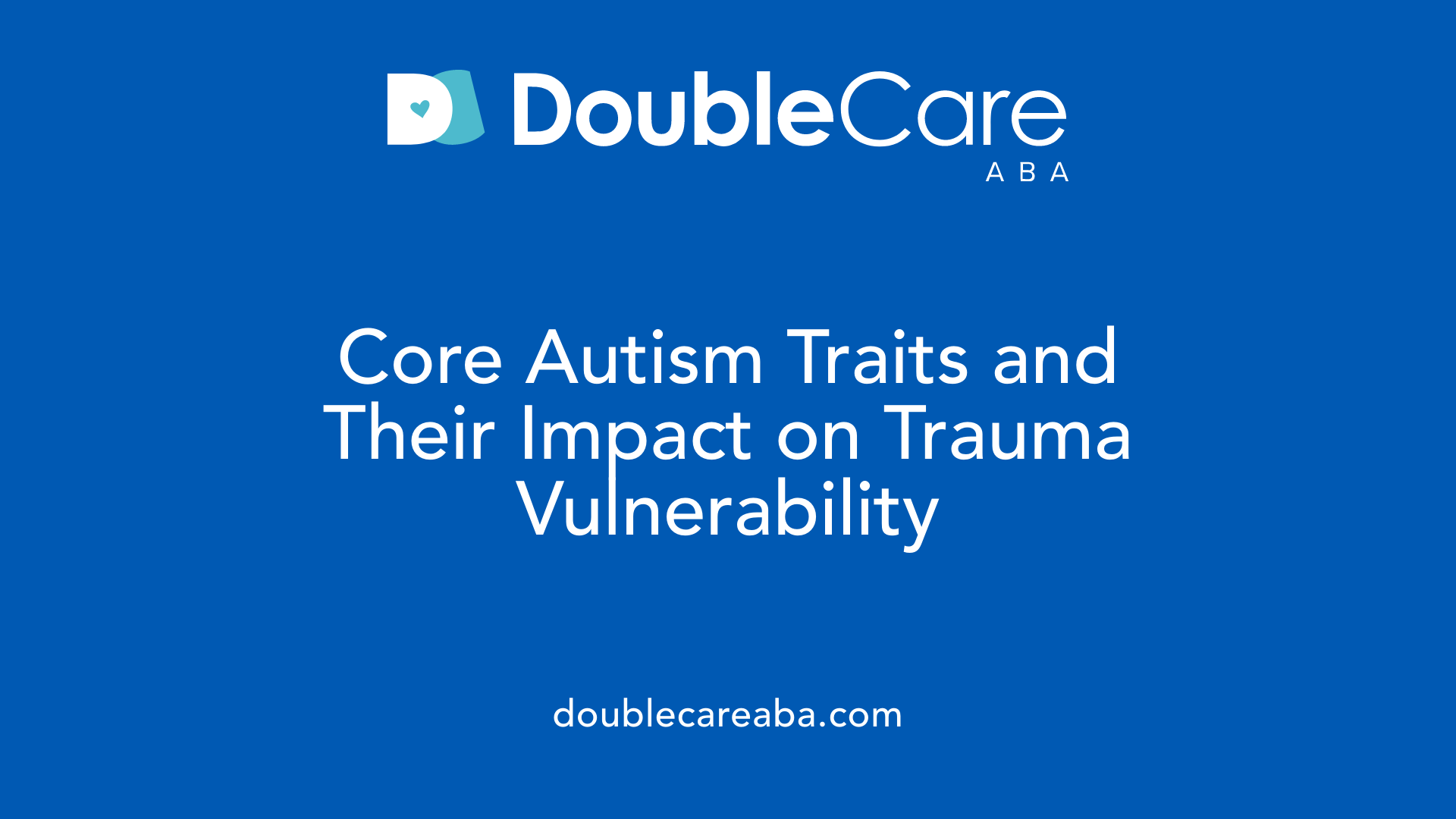
What neurological and behavioral traits define ASD?
Autism Spectrum Disorder (ASD) is characterized by neurological differences present from birth, which influence behavior and development. Individuals with ASD typically show persistent and predictable behaviors such as repetitive actions and a strong insistence on sameness. These neurodevelopmental traits also affect sensory processing, leading to hypersensitivities to stimuli from the environment.
How do communication and social interaction deficits manifest in ASD?
People with ASD experience significant challenges in social communication and interaction. These difficulties often include trouble with verbal and nonverbal communication, understanding figurative language, and engaging in typical social reciprocity. Social withdrawal in ASD is intrinsic and longstanding, differing from trauma-induced withdrawal which stems from fear or anxiety.
What are the theory of mind and cognitive flexibility deficits in ASD?
A crucial cognitive characteristic of ASD is an impaired theory of mind, which is the ability to understand other people’s thoughts, feelings, and intentions. Alongside this, deficits in cognitive flexibility make it hard for individuals to adapt to change or shift perspectives. These limitations impact emotional understanding and processing.
How do these core features increase vulnerability to trauma?
The combination of social naiveté, difficulties in communication, and challenges in social cognition heighten the risk of encountering traumatic experiences such as abuse and victimization. Additionally, impaired theory of mind and reduced cognitive flexibility interfere with processing traumatic memories, increasing the likelihood of developing post-traumatic stress disorder (PTSD). Core ASD symptoms can thus intensify the impact of trauma by exacerbating difficulties in emotional regulation and social support utilization.
| Core ASD Characteristics | Description | Impact on Trauma Susceptibility |
|---|---|---|
| Neurological differences | Present from birth; affect sensory and behavioral regulation | Heightens stress response and sensory overload |
| Communication deficits | Challenges in verbal/nonverbal cues and language comprehension | Increased social isolation and vulnerability to misunderstanding |
| Social interaction issues | Difficulty engaging in typical social exchanges | Raises risk of social manipulation and abuse |
| Theory of mind impairments | Difficulty reading others’ emotions and intentions | Limits trauma processing and support-seeking |
| Cognitive inflexibility | Rigid thinking and routines | Hampers adaptation to trauma and recovery processes |
How Trauma Affects Individuals with Autism: Cognitive and Emotional Implications
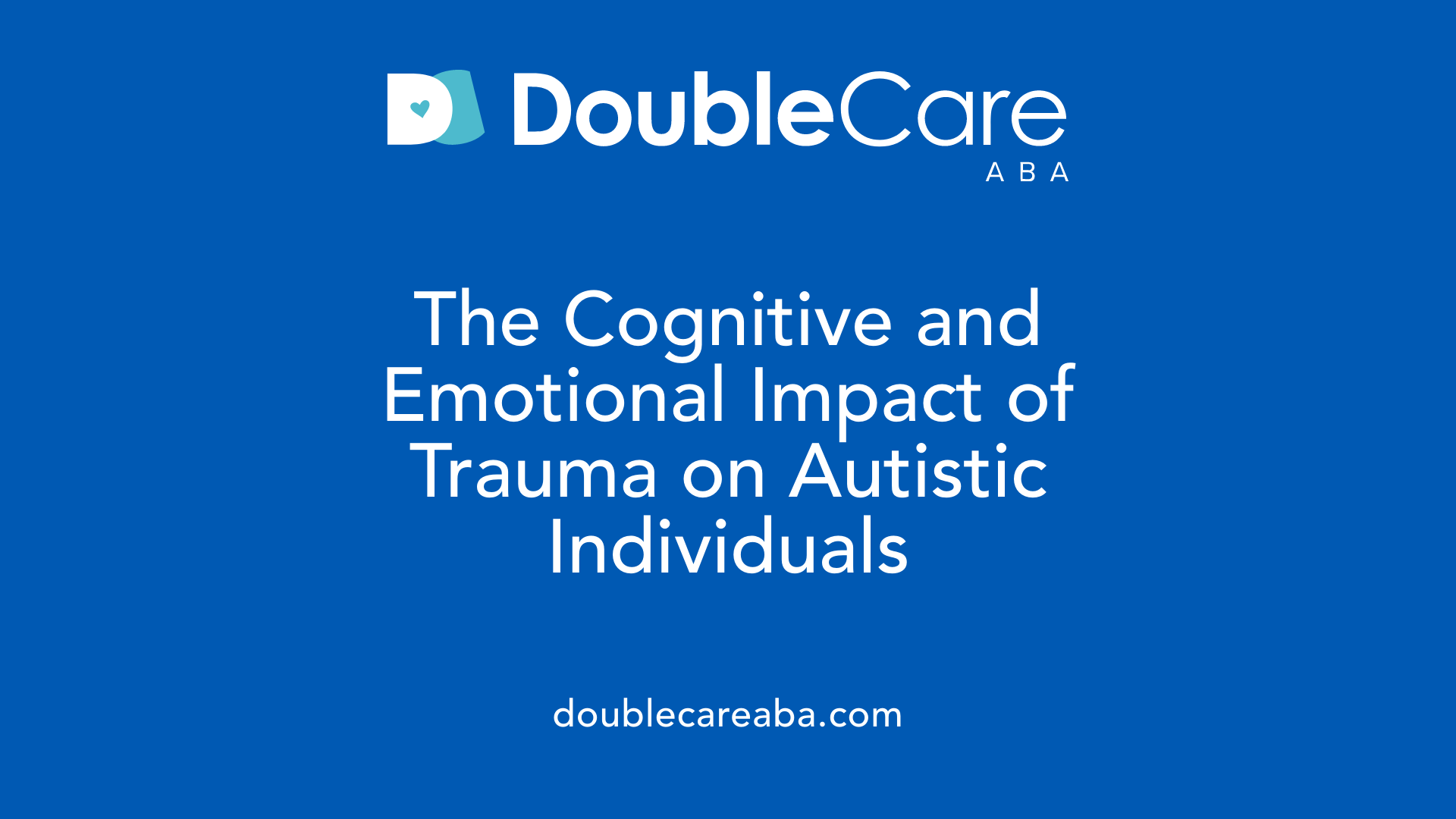
Impact of Trauma on Communication
Traumatic experiences can significantly impair communication abilities in individuals with Autism Spectrum Disorder (ASD). While ASD inherently involves early-onset challenges in speech development and understanding nonverbal cues, trauma can cause regression or selective mutism triggered by anxiety. This added layer may lead to increased difficulty expressing needs or feelings, complicating interactions with caregivers and peers.
Worsening of Social Interaction Difficulties
Social communication deficits are a core feature of ASD; however, trauma amplifies these challenges. Trauma often leads to social withdrawal stemming from fear, distrust, and anxiety. In ASD, these social difficulties become more pronounced after trauma exposure, potentially exacerbating isolation and impairing the development of peer relationships.
Effect on Motor Skills
In addition to communication and social interaction, trauma negatively impacts motor skills in children and youth with ASD. This can manifest as increased motor coordination issues or deterioration in previously acquired motor abilities, which further hinders daily functioning and adaptive behavior development.
Emotion Processing Challenges
Both ASD and trauma influence emotional experiences, but trauma adds complexity to emotion processing deficits common in ASD. Individuals with autism may already have difficulty recognizing and regulating emotions, and trauma can intensify symptoms such as intrusive memories or hypervigilance. Emotional responses after trauma are frequently linked to specific triggers, compounding existing challenges in understanding and managing emotions.
This interaction between trauma and the cognitive-emotional profile of ASD calls for specialized intervention approaches that address these overlapping difficulties to support improved communication, social engagement, motor skills, and emotional regulation.
Difference Between Autism and PTSD: Origins and Symptomatology
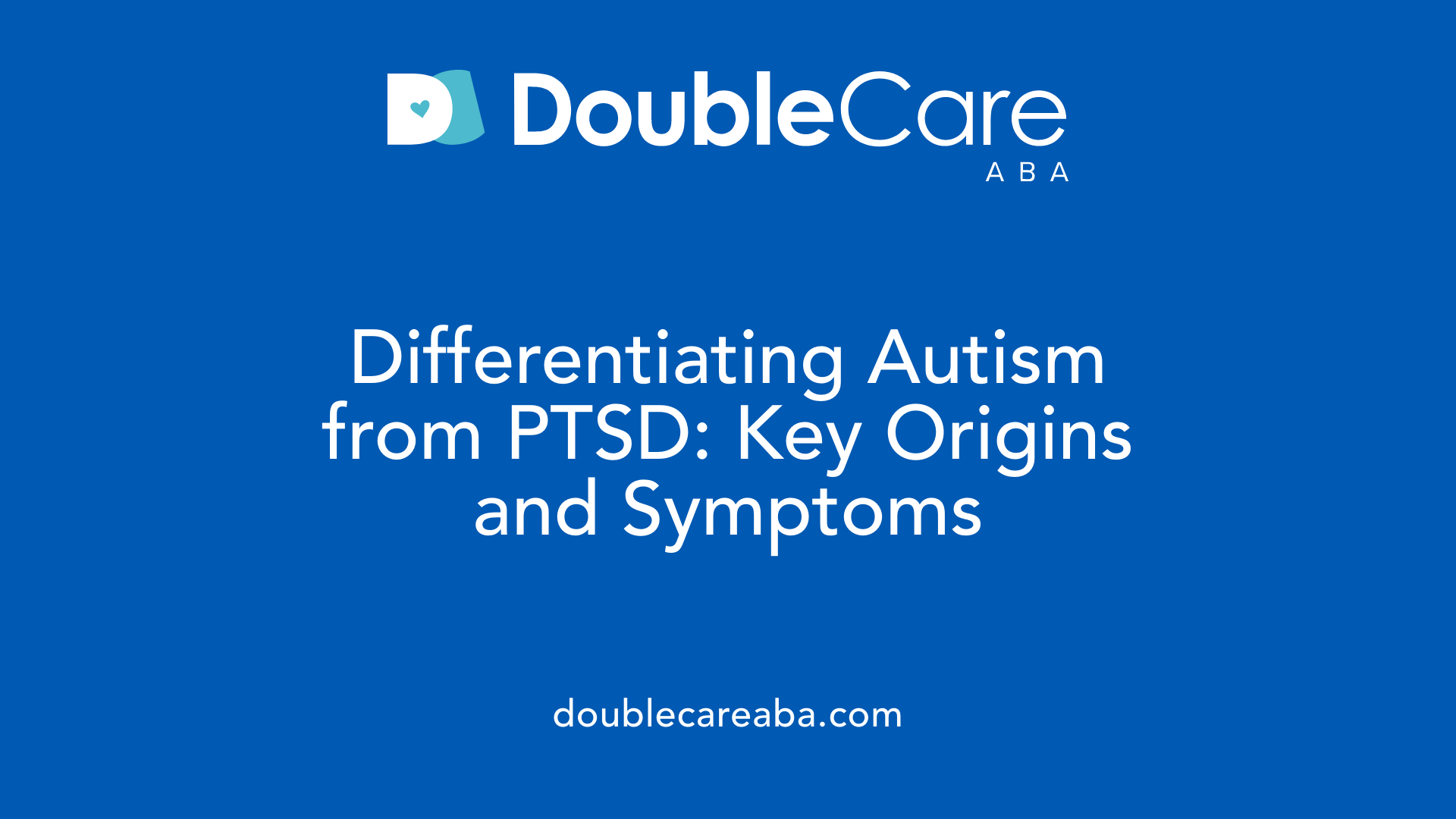
Autism Spectrum Disorder (ASD) as a Neurodevelopmental Condition Present from Birth
ASD is a neurological condition characterized by differences present from birth. It involves persistent and predictable behaviors such as repetitive actions, insistence on sameness, and intrinsic social communication challenges. These features arise due to neurodiversity rather than as a reaction to any event.
PTSD Arising from Traumatic Events
In contrast, PTSD develops following exposure to traumatic incidents like abuse, neglect, or significant life changes. Symptoms include intrusive memories, nightmares, hypervigilance, and emotional numbness. PTSD is acquired rather than congenital, triggered by specific traumatic experiences.
Distinct Patterns of Behaviors and Emotional Responses
Individuals with ASD show unique social communication deficits, emotion recognition difficulties, and rigid behaviors linked to their neurodevelopmental profile. Emotional responses may be intense but are often disconnected from immediate situations.
PTSD-related emotional reactions are usually tied to trauma reminders and specific triggers. Trauma can also lead to regressive communication, selective mutism, and behaviors aimed at avoiding distressing stimuli, unlike the early-onset and stable communication differences seen in ASD.
Social Withdrawal Differences
Social withdrawal in PTSD typically comes from fear, distrust, and anxiety after trauma exposure. In ASD, social challenges and withdrawal stem from inherent differences in social cognition and communication style that are lifelong and not trauma-induced.
Understanding these fundamental differences helps clinicians provide appropriate diagnoses and tailored interventions for individuals exhibiting overlapping symptoms of ASD and PTSD.
Signs of Trauma and PTSD in Autistic Individuals: Behavioral and Internal Indicators
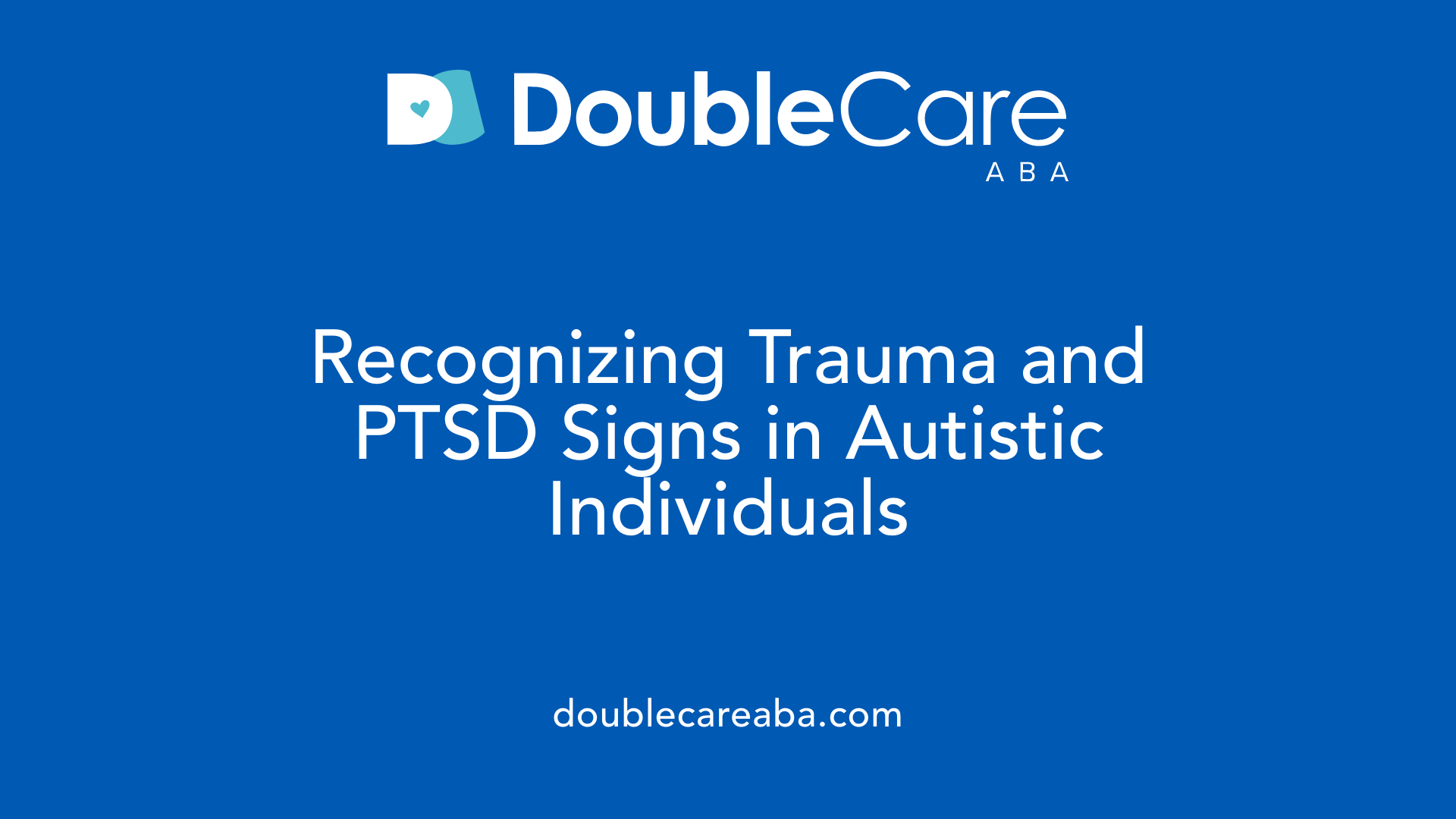
What Are Trauma-Related Behaviors Seen in Autistic Individuals?
Trauma in autistic individuals often presents through behaviors such as hypervigilance, nightmares, and avoidance. These behaviors can arise after specific traumatic incidents like abuse, neglect, or significant life changes. Hypervigilance involves an increased state of alertness to potential threats, often leading to anxiety and difficulty relaxing.
Nightmares and sleep disturbances are common, reflecting intrusive traumatic memories. Avoidance behaviors include steering clear of reminders linked to trauma, which can severely impact daily functioning.
How Do New Behavioral Difficulties Indicate Trauma in Autism?
In individuals with autism, trauma can lead to noticeable new behavioral challenges. Parents and caregivers might observe increased agitation, irritability, or regression in previously learned skills. A sudden rise in behavioral outbursts or withdrawal may signal distress related to trauma.
What Role Do Increased Repetitive Behaviors Play?
Autistic individuals experiencing trauma might exhibit heightened repetitive behaviors. These could include repetitive movements, rituals, or insistence on sameness, potentially serving as coping mechanisms to manage overwhelming stress or emotional turmoil.
What Internal Signs Should Be Recognized?
Internally, trauma manifests as intrusive thoughts and emotional distress. Autistic individuals may experience recurrent distressing memories or nightmares about traumatic events. Emotional reactions might be intense and sometimes appear disconnected from the current situation due to difficulties in emotional processing.
Recognizing these behavioral and internal indicators is crucial for early trauma identification and intervention in autistic individuals, helping tailor support that addresses both their ASD-related needs and trauma-related symptoms.
Challenges in Diagnosing PTSD within the Autism Population
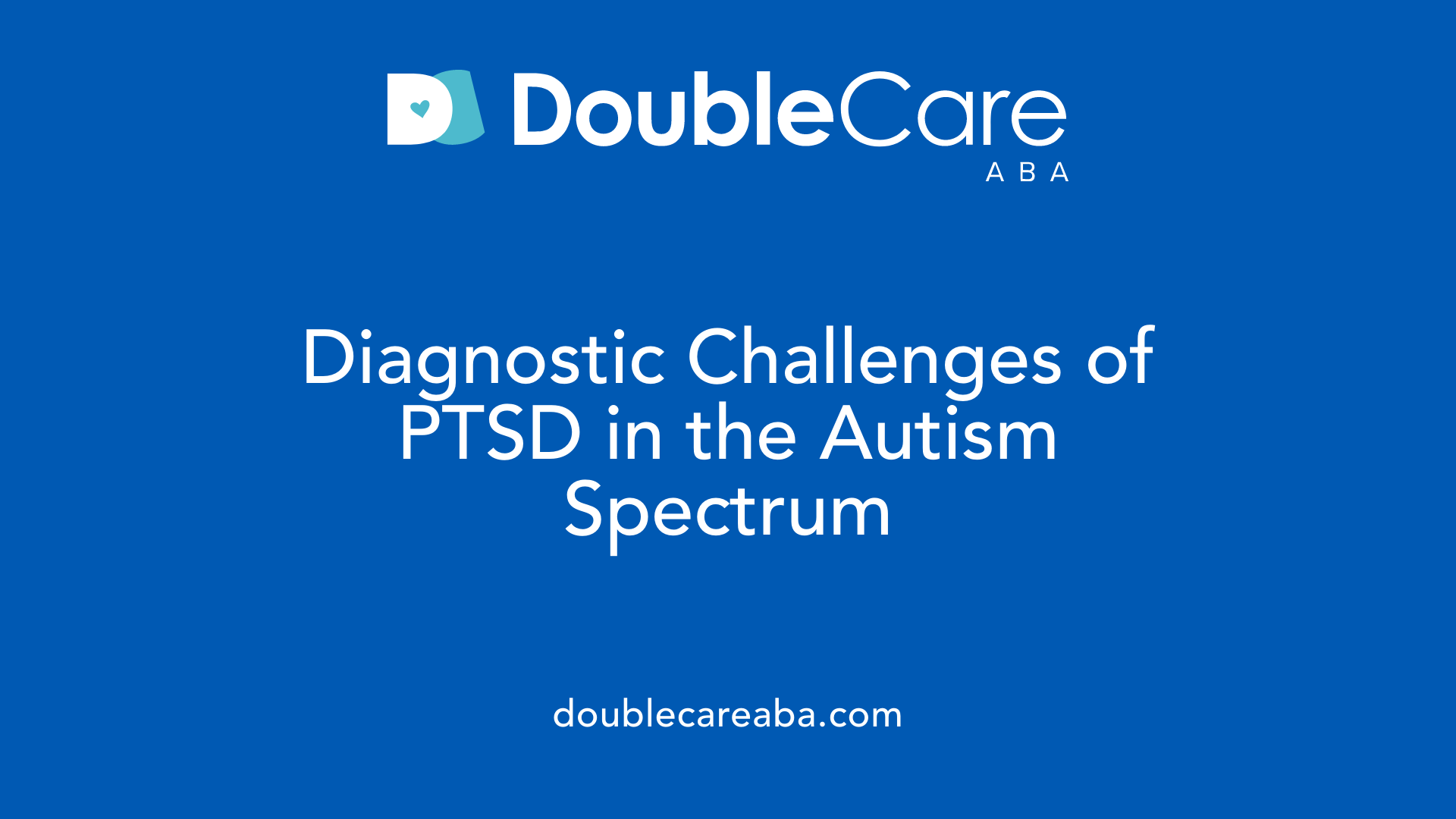
Why is it difficult to diagnose PTSD in individuals with autism spectrum disorder (ASD)?
Diagnosing PTSD within the autism population presents unique challenges due to several factors. First, there is a lack of trauma assessment tools specifically validated for individuals with ASD. This absence makes it harder to accurately identify PTSD symptoms that may manifest differently than in the general population.
How does symptom overlap between ASD and PTSD complicate diagnosis?
Symptoms of PTSD often overlap with characteristics of ASD, such as communication difficulties, social withdrawal, and behavioral changes. For example, increased repetitive behaviors or social communication deterioration can indicate trauma but also align with ASD core features. This symptom complexity requires careful interpretation to avoid misdiagnosis.
Why are comprehensive professional evaluations important?
Given these diagnostic difficulties, professional evaluations by trained psychologists, pediatricians, or psychiatrists are essential. Such comprehensive assessments review trauma history, symptom presentation, and co-occurring conditions. This thorough approach helps differentiate PTSD from autism-related behaviors and ensures appropriate treatment planning.
How do co-occurring conditions affect PTSD diagnosis in ASD?
Individuals with ASD often have co-occurring conditions like anxiety, mood disorders, or ADHD, which can mask or mimic PTSD symptoms. This complicates trauma assessment further, emphasizing the need for specialists to consider the full clinical picture when diagnosing PTSD within this population.
Evidence for Applying DSM-5 PTSD Criteria to Individuals with ASD

How valid are the DSM-5 PTSD criteria for individuals with autism?
Research shows that the current DSM-5 criteria for diagnosing post-traumatic stress disorder (PTSD) can be validly applied to individuals with autism spectrum disorder (ASD). Despite differences in communication styles and cognitive profiles, the core PTSD symptoms such as intrusive memories, nightmares, and hypervigilance are identifiable in people with ASD.
What research supports the diagnosis of PTSD in the autism population?
Empirical studies indicate higher rates of PTSD in individuals with ASD compared to the general population, affirming that PTSD diagnosis using DSM-5 criteria is meaningful. Adaptations in assessment methods have demonstrated that trauma symptoms can be distinguished from autism-specific behaviors, allowing clinicians to diagnose PTSD accurately. Moreover, research underscores the risk of trauma due to vulnerability derived from ASD traits like social naiveté and emotion processing difficulties.
What are the clinical implications for assessing PTSD in individuals with ASD?
Clinicians must recognize that PTSD can coexist with autism and may require tailored approaches in evaluation. Utilizing caregiver input and visual tools can improve assessment accuracy. Identifying trauma symptoms alongside ASD traits is crucial, as timely and accurate diagnosis enables effective intervention with adapted trauma-focused therapies. This confirms the clinical importance of applying DSM-5 criteria thoughtfully in this unique population.
Neurobiological Factors Linking ASD and Trauma Responses
How does heightened stress responsivity affect individuals with ASD?
Individuals with autism spectrum disorder (ASD) often exhibit heightened stress responsivity. This means that their nervous systems react more intensely to stressors compared to neurotypical individuals. This amplified stress response can lead to greater emotional and behavioral difficulties when faced with traumatic events, making ASD individuals more vulnerable to trauma.
What role do increased cortisol levels play in ASD trauma reactions?
Research indicates that people with ASD may have elevated cortisol levels, a hormone released during stress. High cortisol can affect brain function, particularly areas involved in emotion regulation and memory processing. This hormonal imbalance can exacerbate trauma reactions, potentially contributing to symptoms commonly observed in post-traumatic stress disorder (PTSD).
How are emotion regulation deficits connected to trauma in ASD?
Emotion regulation deficits are common in ASD and involve difficulty managing and responding to emotional experiences appropriately. These deficits can intensify trauma responses by impairing the individual's ability to cope with distressing memories or triggers, leading to intensified symptoms such as anxiety, irritability, and social withdrawal.
Why might individuals with ASD be predisposed to severe trauma reactions?
The combination of heightened stress responsivity, increased cortisol levels, and emotion regulation challenges creates a neurobiological environment that predisposes individuals with ASD to more severe reactions to trauma. This can result in a higher likelihood of developing post-traumatic stress disorder (PTSD) and more complex trauma symptomatology.
Table: Neurobiological Factors in ASD and Trauma
| Factor | Description | Impact on Trauma Response |
|---|---|---|
| Heightened Stress Responsivity | Overreactive nervous system to stress | Intensifies emotional and behavioral reactions |
| Increased Cortisol Levels | Elevated stress hormone affecting brain areas | Impairs emotional regulation and memory management |
| Emotion Regulation Deficits | Challenges in managing emotional experiences | Leads to difficulty coping with trauma symptoms |
| Predisposition to Severe Trauma Reactions | Combined neurobiological vulnerabilities | Increases risk and severity of PTSD in individuals with ASD |
Overview of PTSD Treatment Approaches Adapted for Autism
Trauma-Focused Cognitive Behavioral Therapy (TF-CBT) adaptations
Trauma-Focused Cognitive Behavioral Therapy (TF-CBT) has been recognized as an effective approach to treating PTSD symptoms. For individuals with autism spectrum disorder (ASD), TF-CBT requires specific modifications to address communication, cognitive, and social challenges typical of ASD. These adaptations help make the therapy more accessible, understandable, and beneficial for autistic clients.
Use of Visual Aids and Social Stories
To accommodate differences in communication and learning styles, therapists incorporate visual aids like pictures, diagrams, and drawings during sessions. Social stories, which explain social situations and expected behaviors through simple narratives, are also used to help clients understand trauma concepts and therapy procedures. These tools support clearer communication and reduce anxiety by providing predictable, concrete information.
Caregiver Involvement
Active involvement of caregivers is crucial in TF-CBT for autistic individuals. Caregivers provide important insight into their child's behaviors and help reinforce skills learned in therapy outside sessions. They also assist in creating a supportive environment that fosters safety and emotional regulation, which are essential for trauma recovery.
Simplifying Therapy Language
Therapists simplify the language used during sessions to ensure comprehension. Clear, concrete wording is preferred over abstract or figurative language to accommodate difficulties that some autistic individuals face with figurative speech and complex instructions. This fosters better engagement and understanding of therapeutic content.
Tailoring Exposure and Narrative Exercises
Exposure exercises and trauma narratives are adapted by incorporating concrete, visual, or play-based methods to suit the client's processing style. For example, the trauma narrative might be created through drawings or role-play rather than verbal recounting alone. Therapy also addresses core ASD symptoms such as insistence on sameness, enhancing comfort and effectiveness.
These adaptations optimize TF-CBT for autistic clients, providing individualized support that acknowledges their unique strengths and challenges while addressing PTSD symptoms effectively.
Applied Behavior Analysis (ABA) Therapy: Foundations and Techniques
What is Applied Behavior Analysis (ABA) therapy?
Applied Behavior Analysis (ABA) therapy is a science-based intervention grounded in learning theory, particularly operant conditioning. It focuses on increasing positive, helpful behaviors—such as communication, social interaction, attention, and academic skills—while reducing behaviors that may be harmful or disruptive.
Core Principles of ABA
ABA is built on the principle that behavior is influenced by its consequences. The therapy employs the Antecedent-Behavior-Consequence (ABC) model to analyze and modify behavior. This model examines what happens before a behavior (antecedent), the behavior itself, and what happens after (consequence) to better understand and influence behavior patterns.
Common ABA Techniques
Several well-established ABA methodologies are used based on the individual's needs:
- Discrete Trial Training (DTT): Breaks skills into small, manageable steps and teaches each step intensively.
- Pivotal Response Treatment (PRT): Targets pivotal areas like motivation and self-management to produce broad improvements.
- Early Start Denver Model (ESDM): Integrates play-based and relationship-focused interactions with ABA principles, especially for young children.
ABA also employs prompting strategies to encourage desired responses and reinforcement techniques to increase positive behaviors by providing rewards or praise.
Implementation and Effectiveness
ABA programs involve detailed assessments to create individualized treatment plans tailored to each person's strengths and needs. Progress is closely monitored to adjust strategies as required. Trained professionals, such as Board Certified Behavior Analysts (BCBAs) and Registered Behavior Technicians (RBTs), typically deliver ABA therapy.
Research supports ABA’s effectiveness, especially for children with autism spectrum disorder, helping them develop essential skills and manage behaviors that impact daily functioning. Continued research aims to refine these methods and optimize long-term outcomes.
How ABA Therapy Supports Individuals with Autism
How does ABA therapy help individuals with autism?
Applied Behavior Analysis (ABA) therapy plays a crucial role in supporting individuals with autism by focusing on developing essential skills and managing behaviors effectively. It uses a scientific approach to understand behavior through the Antecedent-Behavior-Consequence (ABC) model, allowing therapists to identify triggers and responses clearly.
Role of ABA in skill development
ABA therapy targets increasing helpful behaviors such as communication, social interaction, attention, and independence. By setting specific, measurable goals, therapists tailor programs that foster progress in language, social skills, and daily living activities. Early and intensive ABA interventions have shown significant improvements in overall functioning.
Improving communication and social interaction
One of the primary focuses of ABA is enhancing communication abilities and social interactions. Techniques include breaking down complex behaviors into smaller steps and using positive reinforcement to encourage progress, enabling individuals to better express themselves and engage with others.
Behavior modification using positive reinforcement
ABA relies heavily on positive reinforcement to reduce harmful or challenging behaviors while promoting desirable skills. Reinforcers such as praise, tokens, or preferred activities motivate individuals to repeat helpful actions.
Tailored programs and goal-setting
Tailored programs are designed by qualified professionals according to each individual's unique needs and strengths. These programs emphasize measurable goals across different developmental domains and are flexible to accommodate progress and challenges.
Settings across home, school, and community
ABA interventions are versatile and can be implemented in various settings—including home, school, and community environments—to ensure skills generalize across different situations. Consistent support and collaboration with caregivers and educators enhance treatment effectiveness and improve quality of life.
Altogether, ABA provides structured, evidence-based support that adapts to each person with autism, facilitating meaningful skill development and behavior management.
Who Provides ABA Therapy and How Is It Delivered?
Providers of ABA Therapy
ABA therapy is primarily delivered by licensed or certified professionals who specialize in behavior analysis. The most commonly known providers are Board Certified Behavior Analysts (BCBAs). Other licensed therapists and specialized behavioral service providers also administer ABA therapy, depending on the specific needs of the individual.
Settings for Delivery
ABA therapy is highly versatile and can be provided across a variety of environments. Common settings include clinics, schools, and homes, enabling therapists to tailor the intervention to real-world contexts. Additionally, community-based programs offer opportunities for social skills development. Telehealth has emerged as a valuable delivery method, particularly useful for reaching individuals in remote areas or providing continuity during challenging times like the COVID-19 pandemic.
Requirements for Evaluation and Diagnosis
To initiate ABA therapy, especially for children and adolescents under 20, a thorough evaluation by qualified professionals is essential. Typically, a written order from a recognized Centers of Excellence (COE) provider is required to confirm the diagnosis of Autism Spectrum Disorder (ASD) and authorize therapy services. For adults, diagnosis and therapy orders often involve neurologists, psychiatrists, or psychologists who assess and recommend appropriate therapeutic interventions.
Expanding Accessibility through Telehealth and Caregiver Coaching
Telehealth has significantly expanded access to ABA therapy. It allows therapists to conduct sessions remotely, offering flexibility and reducing barriers such as travel time or geographic limitations. Caregiver coaching through telehealth is a vital component, empowering families with training to support their loved ones effectively. This approach ensures a collaborative treatment model and promotes skill generalization across daily environments.
ABA therapy's adaptability in provider qualifications, treatment environments, and delivery methods ensures that individuals with ASD receive personalized and accessible support to develop essential skills and manage behaviors effectively.
Techniques Commonly Used in ABA Therapy for Autism
What techniques are commonly used in ABA therapy?
Applied Behavior Analysis (ABA) therapy employs a variety of techniques designed to teach essential skills and manage behaviors in individuals with autism spectrum disorder (ASD). One of the foundational methods is Discrete Trial Training (DTT), which breaks down skills into small, manageable steps and teaches them through repeated trials with clear prompts and reinforcements.
Another approach is Natural Environment Training, which involves teaching skills in the settings where they naturally occur, like home or school, fostering generalization of learning. Behavior chaining builds complex behaviors by linking together simpler ones learned separately.
To encourage skill acquisition, therapists use prompting and fading strategies—starting with more assistance and gradually reducing support as the individual gains independence. ABA also incorporates behavior reduction strategies such as extinction (ignoring unwanted behaviors) and redirection to discourage negative or harmful actions.
Central to ABA is reinforcement. Both positive reinforcement, like giving a reward when a desirable behavior occurs, and negative reinforcement, removing an unpleasant stimulus, motivate behavior change. Visual supports, including modeling, video modeling, charts, and verbal prompts, play a crucial role, especially for individuals with challenges in language or communication. These help clarify expectations and make abstract concepts more concrete.
Additional techniques include behavior contracts (agreements outlining behavioral goals), script fading (gradually reducing reliance on scripted dialogues), and social skills training using role-playing and imitation. These methods are always tailored to individual needs, with therapists continuously collecting data to monitor progress and adjust interventions.
Through this diverse set of strategies, ABA therapy provides structured and flexible support to help individuals with ASD develop adaptive behaviors and thrive in daily life.
Scientific Evidence Supporting ABA Therapy
What is the evidence supporting the effectiveness of ABA therapy for autism?
Applied Behavior Analysis (ABA) therapy stands as the gold standard in interventions for individuals with autism, supported by extensive scientific research. Studies consistently show that ABA contributes significantly to improvements in communication abilities, social skills, and adaptive behaviors essential for daily functioning.
Individualized and intensive ABA programs create the most profound impact. These tailored approaches use reinforcement, skill modeling, and naturalistic teaching strategies to address each person's unique needs, leading to measurable gains in social interaction and emotional regulation. Early implementation of ABA has been linked to marked increases in language development, enabling participants to communicate more effectively.
In addition to fostering communication and social interaction, ABA therapy has been shown to reduce problematic behaviors frequently observed in autism spectrum disorder (ASD), such as repetitive actions or aggression. By targeting such behaviors, ABA not only supports behavior reduction but also promotes greater independence, equipping individuals to better navigate everyday life challenges.
Moreover, the research highlights the importance of consistency and intensity in ABA interventions. Programs delivered over extended periods with high frequency tend to yield stronger and more durable outcomes. While some limitations and individual variability exist, ABA remains one of the most empirically validated and widely used therapeutic approaches for enhancing the quality of life in children and adults with autism.
Integrating Trauma-Informed Care within Autism Treatment Paradigms
Why Is Addressing Trauma Important in Autism Therapy?
Individuals with autism spectrum disorder (ASD) are at a higher risk of experiencing traumatic events such as abuse and neglect. Trauma can significantly worsen core autism challenges including social communication difficulties and behavioral regulation. This increased vulnerability, combined with ASD-related differences in emotional processing and stress response, means trauma-informed care is essential for effective therapy. Without addressing trauma, autistic individuals may experience persistent distress that traditional autism therapies alone might not fully resolve.
How Can ABA and Other Autism Therapies Be Adapted to Consider Trauma Effects?
Applied Behavior Analysis (ABA) remains a cornerstone in autism treatment, focusing on skill-building and behavior management. However, trauma can manifest as new behavioral challenges or increased repetitive behaviors, which necessitate adjustments in therapeutic approaches. Incorporating trauma-informed adjustments involves:
- Using visual supports like social stories to explain therapy goals clearly.
- Simplifying language to reduce anxiety and promote understanding.
- Tailoring exposure-based exercises with concrete, play-based techniques that respect sensory sensitivities.
- Actively involving caregivers to reinforce safety and predictability.
Similarly, adaptations of Trauma-Focused Cognitive Behavioral Therapy (TF-CBT) for autistic clients include visual aids and structured sessions aligned with ASD strengths and challenges.
What Role Does Collaboration Between Trauma and Autism Specialists Play?
Because trauma symptoms in ASD can overlap with or mask autism features and vice versa, interdisciplinary collaboration is crucial. Trauma specialists bring expertise in recognizing trauma signs and implementing sensitive interventions, while autism professionals understand neurodevelopmental factors and communication needs. Together, they can create tailored treatment plans that address both conditions. This collaborative approach enhances diagnosis accuracy and improves therapy outcomes.
Why Is Caregiver Involvement and Environmental Support Crucial?
Caregivers play a central role in supporting individuals with ASD who have experienced trauma. Their involvement helps generalize skills learned in therapy to everyday environments. Utilizing visual schedules, social stories, and establishing predictable routines in home and school settings foster a sense of safety and stability. Additionally, caregiver education on trauma impacts and coping strategies is vital for sustained progress.
Integrating trauma-informed approaches within autism therapies ensures a holistic treatment model that addresses both neurodevelopmental and trauma-related needs. This integration supports more effective healing and skill development, enhancing overall quality of life for individuals with ASD.
The Role of Caregivers and Support Systems in Managing Trauma and Autism
Active Caregiver Participation in Therapy
Caregivers play an essential role in the therapeutic process for individuals with autism spectrum disorder (ASD) who have experienced trauma. Their active involvement helps tailor interventions like Trauma-Focused Cognitive Behavioral Therapy (TF-CBT) to the unique needs of the individual, ensuring communication challenges and cognitive differences are accommodated. Caregivers provide vital insights about behavioral changes, assist with homework between sessions, and help reinforce strategies learned in therapy.
Use of Visual Schedules and Social Stories
Visual supports such as visual schedules and social stories are critical tools used by caregivers and therapists to help individuals with ASD navigate changes and understand trauma-related therapy tasks. These supports provide clear, predictable structures which reduce anxiety and improve comprehension. Social stories guide individuals through unfamiliar emotional scenarios or behaviors linked to trauma, promoting safer responses and easing transitions.
Supporting Generalization of Skills
Caregivers help generalize new skills acquired in therapy across different environments — home, school, and community settings. By consistently reinforcing coping strategies and adaptive behaviors, they ensure that therapeutic gains are maintained and integrated into daily life. This consistent reinforcement is especially important given the challenges individuals with ASD face in transferring skills.
Creating Safe and Attuned Environments
A safe and attuned environment is vital for trauma recovery in ASD. Caregivers foster this by recognizing triggers, providing emotional support, and maintaining routines that help reduce sensory overload and stress. Their understanding and responsiveness contribute significantly to reducing hypervigilance and distress symptoms, facilitating emotional regulation and healing.
Together, these caregiver-driven strategies form a supportive framework that addresses both the complexities of autism and trauma, enhancing therapeutic outcomes and daily functioning.
Current Research Gaps and Future Directions in PTSD and Autism Intersection
What Are the Needs for ASD-Specific Trauma Assessment Instruments?
Despite the growing understanding of trauma in individuals with autism spectrum disorder (ASD), a significant research gap exists in the development of validated trauma assessment tools tailored for this population. Presently, clinicians rely mainly on general PTSD assessment methods, which often miss subtleties related to ASD characteristics like communication differences and repetitive behaviors that can mask trauma symptoms.
How Is Adapted Trauma Therapy Being Explored for ASD?
Research supports the modification of existing evidence-based trauma treatments, especially Trauma-Focused Cognitive Behavioral Therapy (TF-CBT), to better suit individuals with autism. These adaptations include using visual aids, social stories, drawings, and simplified language to address ASD-related communication and cognitive challenges. Caregiver involvement and strategies for generalizing skills to various settings are integral components. However, larger empirical studies are required to firmly establish the efficacy of these adaptations.
Why Is Collaborative Research Between ASD and Trauma Experts Important?
The intersection of ASD and trauma highlights the need for joint efforts between specialists in neurodevelopmental disorders and trauma psychology. Collaborative research can foster the sharing of clinical insights, promote the design of specialized interventions, and advance comprehensive care models that address both ASD core features and trauma-related issues effectively.
What Are the Goals for Long-Term Effectiveness and Tailored Interventions?
Longitudinal research is essential to understand the lasting impact of trauma interventions adapted for ASD and to tailor these therapies further based on individual profiles. This direction aims to improve outcomes by integrating supports for emotion regulation, sensory sensitivities, and communication differences, creating personalized treatment pathways that enhance quality of life for those affected.
These future research avenues emphasize a more nuanced approach to trauma in autism, encouraging innovation in assessment, therapy, and interdisciplinary collaboration.
Concluding Insights on Distinguishing and Supporting PTSD and Autism
Understanding the intricate relationship between PTSD and Autism Spectrum Disorder is crucial given the growing awareness of trauma’s impact on autistic individuals. While autism is rooted in neurodevelopmental differences evident from birth, PTSD arises from traumatic experiences, yet their symptoms often intersect, challenging effective diagnosis and treatment. Evidence supports that PTSD can be diagnosed within ASD using current criteria and effectively treated with adaptations such as trauma-informed cognitive behavioral therapies. Meanwhile, Applied Behavior Analysis remains the foundational therapy for autism, fostering critical skills and behavior management. Integrating trauma-informed approaches within autism care, involving caregivers, and continuing research into specialized assessment tools and therapies will enhance outcomes. Ultimately, fostering collaboration among professionals and tailoring interventions to individual needs offers the promise of improved support and quality of life for those navigating both autism and trauma-related challenges.
References
- Research Mapping of Trauma Experiences in Autism ...
- Autism and PTSD: Similarities and Differences
- Distinguishing Trauma* from Autism
- Trauma and Autism Spectrum Disorder: Review, Proposed ...
- Applied Behavior Analysis (ABA)
- Applied Behavior Analysis (ABA)
- Applied Behavior Analysis in Children and Youth with ...
- Applied Behavior Analysis (ABA)
- The Top 10 Reasons Children With Autism Deserve ABA














